I am not exactly what you would call a farm-friendly type of gal.
I attended the Sustainable Farm Dinner on Friday evening (part of the AHS after-hours festivities) in the barn, but it was raining pretty hard and the tour that was scheduled for before the dinner was cancelled. When we arrived at the farm for dinner, it was already dark and it wasn't possible to see much of the farm. Bummer.
But, I was invited back a couple of days later for Sunday brunch at the farm with friends. Hooray!
So, this morning I spent a few hours enjoying breakfast and conversation with friends at Clark Farm in Carlisle, MA. At the home of Diana Rodgers of Radiance Nutritional Therapy, we first dined on eggs, wild boar bacon, venison sausage, homemade sauerkraut, and baked eggplant – then we took a tour of the farm. And, I'll admit, while I was psyched to go have a little dine-and-dish with my Paleo friends, I was not super psyched about traipsing around a farm. That was before we started the tour.

The tour of Clark Farm has changed my perspective on just how much I like farms and farm animals.
I'll be the first to admit that while I love to eat animals, I am really not a fan of stomping around in – or even adjacent to – their poop. There, I said it. I think this aversion mostly stems from my aversion to horses and other large animals that developed after riding horses as a child that always seemed to give me trouble. It was them, not me, clearly.
Fast forward 20 years and here I am, a huge proponent of buying locally raised food, yet I really haven't been to a farm to get a tour and learn how my food is raised. Granted, I'm on the road often and had friends in California who had been to the farm where I previously sourced my meats, so I went on their good word as well as on the reputation of the farm. After moving from San Francisco (where I only saw the slaughtering operation of my favorite farm) to New Jersey – and traveling a heck of a lot in this time – I haven't been home long enough to make my way out to see the operation that's one of my new main sources of protein. After touring Clark Farm, I have now put the local trip atop my priority list.
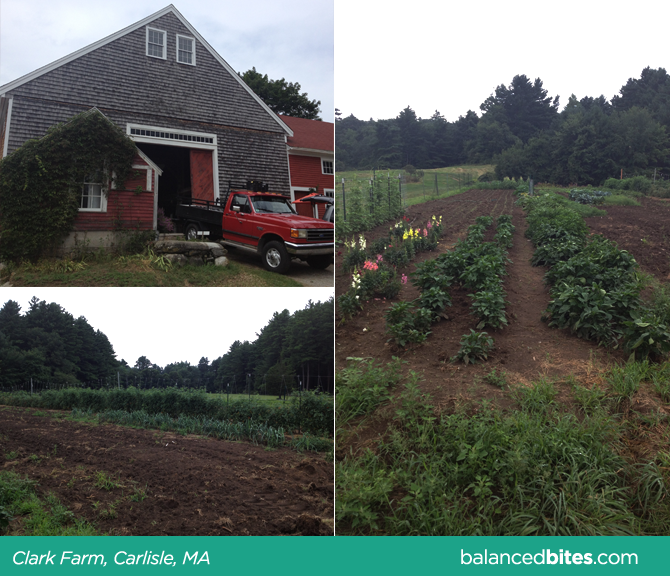
Andrew and Diana Rodgers began our tour of Clark Farm with a quick shoe-swap: flip flops and sneakers off, wellies on.
After confirming the route we'd take to see each set of animals with one another, the couple began to guide myself, Bill and Hayley, Nom–Bomb (and one of their Os) out across the field. We first encountered their “kitchen garden” as it's called – the plantings that will be harvested mainly to feed the families who run the farm, but not for sale publicly. The farm is still pretty new to the couple, so next year's operation will be in even more of its full glory and will operate a CSA when the time comes.
The first stop on our tour: the pigs.
Now, I didn't catch the name of their breed, but man, did they look happy as pigs in you-know-what. To clear up confusion around an appropriate diet for pigs, you should know this: “pigs are omnivores – they eat anything we'd eat,” according to Andrew. A lot of people have commented to me lately that they have trouble finding grass-fed pork products. Well, that's because pigs don't actually eat grass. Pigs aren't ruminants like cows, sheep, bison, and goats. While the pigs are fed grain on this farm, they also root around and eat anything they find in the ground. The pigs are living pretty much the most amazing lifestyle possible, and I'd say they're in just about the pig equivalent of Club Med. Heck, this entire farm is like Club Med for the animals. I noticed how seemingly lean the pigs were when they stood up to romp around in the mud. Apparently each animal only yields about 10 pounds of bacon. While I don't think I had a number in my head as to how many breakfasts one of these muddy buddies would provide, I was somehow surprised to hear 10 pounds, and then immediately considered how I just recently purchased about half of that within a matter of minutes.
A couple of other cool things I learned about pigs:
1. They are about six months old when they are ready to be slaughtered for food.
2. Since they eat pretty much anything, they can be used quite well to clear the random growth of weeds or plants that aren't ideal for other animals like sheep or goats to be munching on. So, they're quite useful in clearing and prepping land in one area before grass is grown purely for other animals to graze upon.
Pigs are cool, and tasty.
Next stop: the sheep.
These guys and gals were happily munching on grass. Andrew pointed out a couple of different breeds to us, some that grow larger, some smaller. Apparently they taste pretty different as well, which makes sense. He's bred a few kinds and has some that he prefers to raise, as I'm sure most farmers do, including a breed from South Africa (if I remember correctly).
Andrew's comments on how to raise sheep were really interesting and summed up the job of a farmer pretty well:
1. Manage (gut) bacteria.
He noted that if the sheep ate the vegetation the pigs were currently clearing away, it would disrupt the bacterial balance in their guts, making them sick and rendering his flock useless. Whoa. Are you picking up what I'm putting down here?! The gut flora in sheep is pretty darned delicate… sound familiar?! I teach people about the balance of bacteria in the human digestive system all the time, but this really got me interested. By only allowing the sheep to eat the proper type of grasses, he keeps them healthy and growing at a steady pace.
2. Move fences.
Since the animals on Clark Farm don't require much feeding outside of what the land provides, Andrew says most of his job is just moving the fences. The animals move around on the pasture and eat as they go. He noted that the height of the grass is important, and he can't let the sheep eat it down too far or they'll risk eating pathogenic/parasitic material in the low grass/dirt/mud. So, once the grass is chew-trimmed to a certain height, he moves the fences and has the sheep graze on a new patch. This should sound familiar to you if you've seen the movie Food, Inc. and heard from Joel Salatain, the self-proclaimed “grass farmer” featured in the film. He grows grass and the animals do the rest.
These two tasks are the main things a farmer needs to focus on for success. Simple, perhaps… but not easy or we'd all be doing it, right?!
Next up: the chickens.
We were pretty eager to check out the chicken coops because we had some egg-citement building (har har…) ever since brunch. Note: see tasty yolks pictured above.
Let's clear up some things about chickens, eggs, and how the whole situation works.
1. Chickens are not vegetarians. They naturally eat bugs, grubs, grasses, and perhaps some grain here or there as they find it. Many pastured chickens aren't given feed at all, while some are given supplemental feed to go along with whatever they scratch up outside. I recommend finding a local farmer whose supplemental feed does not include soy (this isn't easy, but it's possible).
2. To get eggs from hens laying them, a rooster is not required. I know, a lot of you may be thinking, “duh, of course not!” But I know many people aren't aware that chickens will lay about one unfertilized egg per day, and only if a rooster is around to have fertilized them before they pop out would a chicken possibly come to life from it. And unless you know that there's a rooster, addressing them collectively as “ladies” is quite appropriate.
3. Chickens can easily be tricked by decoy eggs. Andrew quickly explained that the plastic egg in the laying coop was there to let the chickens know where to lay eggs versus where to sleep. This keeps the eggs cleaner since the chickens tend to spend more time either outside of the coops or in the sleeping coop, which means they poop less where they lay eggs. Awesome.
4. Chickens will peck at you, so wear boots or long pants and close-toed shoes if you're ever around them. Make a mental note.
Last stop: the goats.
Admittedly I was able to bond with the goats in the barn before and during dinner a couple of nights before our tour, so I already felt like I had a newfound appreciation for these cuties. And, man, are they cute! The two brown ones are bred and raised for milk production, so they tend to be more affectionate towards the farmer, knowing that they'll be around for a while. Conversely, the white ones generally know their days are numbered, and while friendly, are a bit less apt to come over looking for a pet. Andrew pulled down a branch to show us what the goats really love to eat: leaves! He handed me the branch, sensing my previous hesitation around the animals, and offered me the chance to feed them their treat. It was pretty cool.
Another thing I noticed about the goats while we dined near them in the barn was that they're quite attentive. When we all clapped after a speech was given at the dinner, they picked their heads up from noshing on their grassy meal to see what was going on. They didn't seem frightened, but actually interested in the commotion. It was pretty cool to see.
Why supporting local farms matters:
Have you grasped just how much work goes into running this operation? I feel that this experience was really important for me and put me back in touch, literally, with my food and where it comes from – even if mine specifically isn't from Clark Farm since they're not local to me. It's important to support people who are doing this work for us, since we aren't doing it ourselves. We need to buy from those who are taking this amazing burden of feeding ourselves into their hands, with pride, and showing us how they care for our health and that of the land by raising food properly.
It's invaluable to meet your local farmers, to ask about their work, how they care for and raise your food, and to learn something about the entire process. We no longer have to do much to get food on our plates, and people still complain that even just cooking is too hard. I honestly want to challenge people to rethink that statement and take a few minutes to think about how much time, energy, and money goes into raising the food we sometimes take for granted.
If you are reading this post and own or operate a farm who does things in a way similarly to how Andrew and Diana do at Clark Farm, thank you. You are undervalued.
For more information:
Clark Farm – www.clarkfarmcarlisle.com/
Sustainable Dish – www.sustainabledish.com
Radiance Nutritional Therapy – www.radiancenutrition.com
Eat Wild – www.eatwild.com – to find a farmer near you
Local Harvest – www.localharvest.org – to find a farmers market near you (and maybe a farmer, too!)


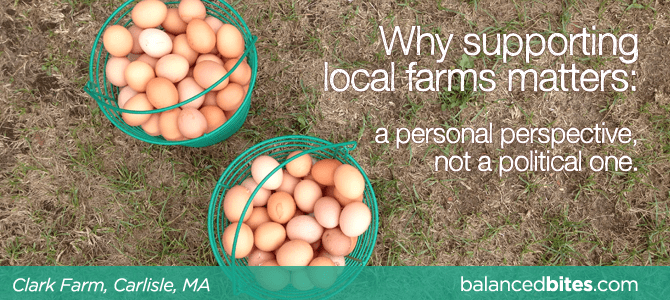
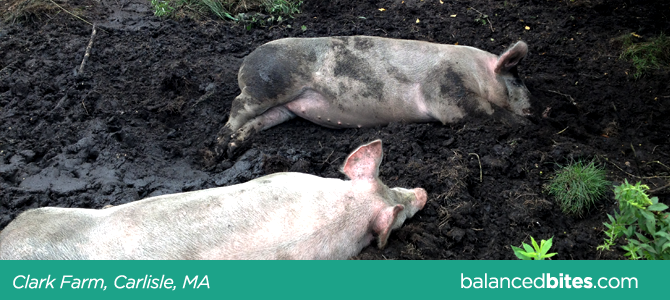
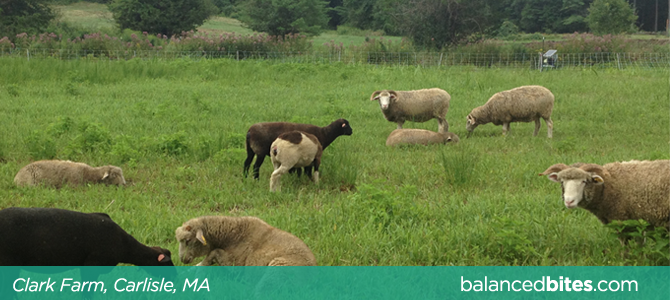
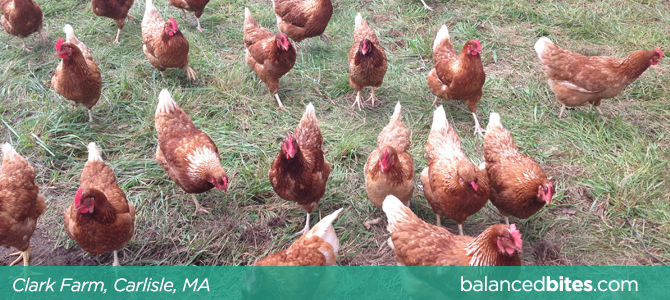

Comments 11
Love this. Thanks for the delightful look inside this farm.
Sounds (and looks) like you had a great time. Thanks for sharing your experiences with us. I am so glad I eat local!
I have celiac disease. Do you think it would be a problem for me to have pork that is fed grains? I’ve sourced a local farm who has pigs but they use grain made up of an old variety of oats, barley and peas. I just want to be safe.
Thanks!
It really depends on the person. Some people with severe autoimmunity find that early-on in their healing, grain-fed animals are tough for them to digest, but later they feel okay. It may be a matter of healing your gut before you are able to eat them, or just some trial-and-error. I do think that grain-fed animals who are not designed to eat grains (like cows, for example) will be more problematic than a grain-fed animal that is adapted to eating grains and can digest them just fine.
I hope that helps!
Thank you!!
Great stuff! Just this morning I read an article in the Toronto Star about young, city-bred women bucking the aging farming trend. I love this new focus these days on how farmers are important and valuable! I grew up on a farm and really appreciate the perspective it gave me and have a dream of having one of my own one day too!
Diane, your book came to my door today – I pre-ordered it months ago! It’s so ridiculously beautiful and packed with info I can’t wait to get into. Thank you!! 🙂
Thank you! Enjoy it! 🙂
Thanks for the great tour and information. I lived on a farm for a summer and so appreciate what they do; but it’s easy to forget when you can just wander over to the store and buy.
I got my book, too. Gorgeous and smart (like you)! 🙂
Great write-up! I’ve been wanting to tour Clark Farm since Diana announced that she was moving there earlier this year. I’m dying to bring the kids there to see all that and get them more connected to where their food comes from. Our own chickens are great, but they think of them as pets, not food or working animals.
Thanks 🙂
What a great post — so informative! Thank you.
As a Dutch person I couldn’t help but notice that the name of your new local farm is Snoep Winkel Farm. Did you know that it means Candy Store in Dutch? I thought that is was a funny yet odd name for a farm. Would love to have a farm like that in San Diego area though….